Readings Newsletter
Become a Readings Member to make your shopping experience even easier.
Sign in or sign up for free!
You’re not far away from qualifying for FREE standard shipping within Australia
You’ve qualified for FREE standard shipping within Australia
The cart is loading…






‘Shanshui City’, the latest book from MAD Architects’ founder and principal partner, Ma Yansong, Ma’s poetic, yet precise language details the development and practice of design philosophy At the core of ‘Shanshui City’ is the idea that, architects should delineate a new ideal for the city of the future, to gradually construct an urban environment that embodies both the convenience of the modern city and the ancient Eastern affinity for the natural world. ‘Shanshui’ is an idealised worldview developed by Chinese through extended contact with the natural world, a worldview that integrates the everyday life of humanity with the impulse to seek spiritual refuge in nature. This ‘Shanshui City’ is not simply an eco-city, or a garden-city, nor does it imply modelling the city’s architecture on natural forms such as mountains. It represents humanity’s affinity for the natural world, and our quest for inner fulfilment, as expressed in philosophies of the East. 103 illustrations
$9.00 standard shipping within Australia
FREE standard shipping within Australia for orders over $100.00
Express & International shipping calculated at checkout
Stock availability can be subject to change without notice. We recommend calling the shop or contacting our online team to check availability of low stock items. Please see our Shopping Online page for more details.
‘Shanshui City’, the latest book from MAD Architects’ founder and principal partner, Ma Yansong, Ma’s poetic, yet precise language details the development and practice of design philosophy At the core of ‘Shanshui City’ is the idea that, architects should delineate a new ideal for the city of the future, to gradually construct an urban environment that embodies both the convenience of the modern city and the ancient Eastern affinity for the natural world. ‘Shanshui’ is an idealised worldview developed by Chinese through extended contact with the natural world, a worldview that integrates the everyday life of humanity with the impulse to seek spiritual refuge in nature. This ‘Shanshui City’ is not simply an eco-city, or a garden-city, nor does it imply modelling the city’s architecture on natural forms such as mountains. It represents humanity’s affinity for the natural world, and our quest for inner fulfilment, as expressed in philosophies of the East. 103 illustrations